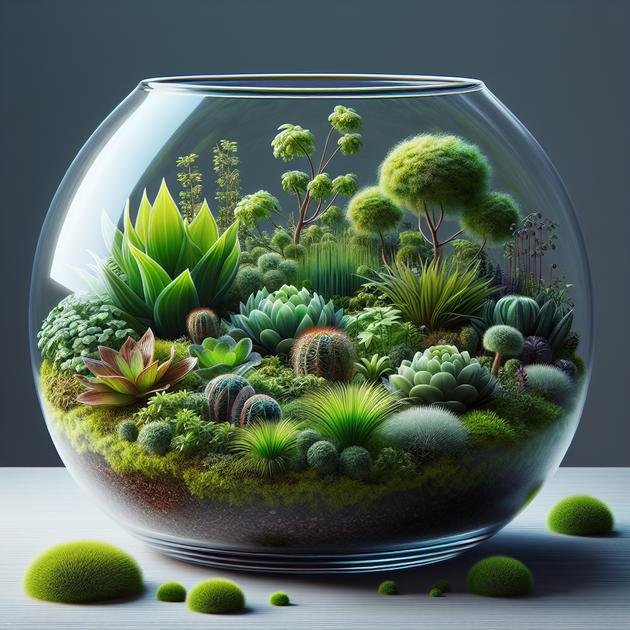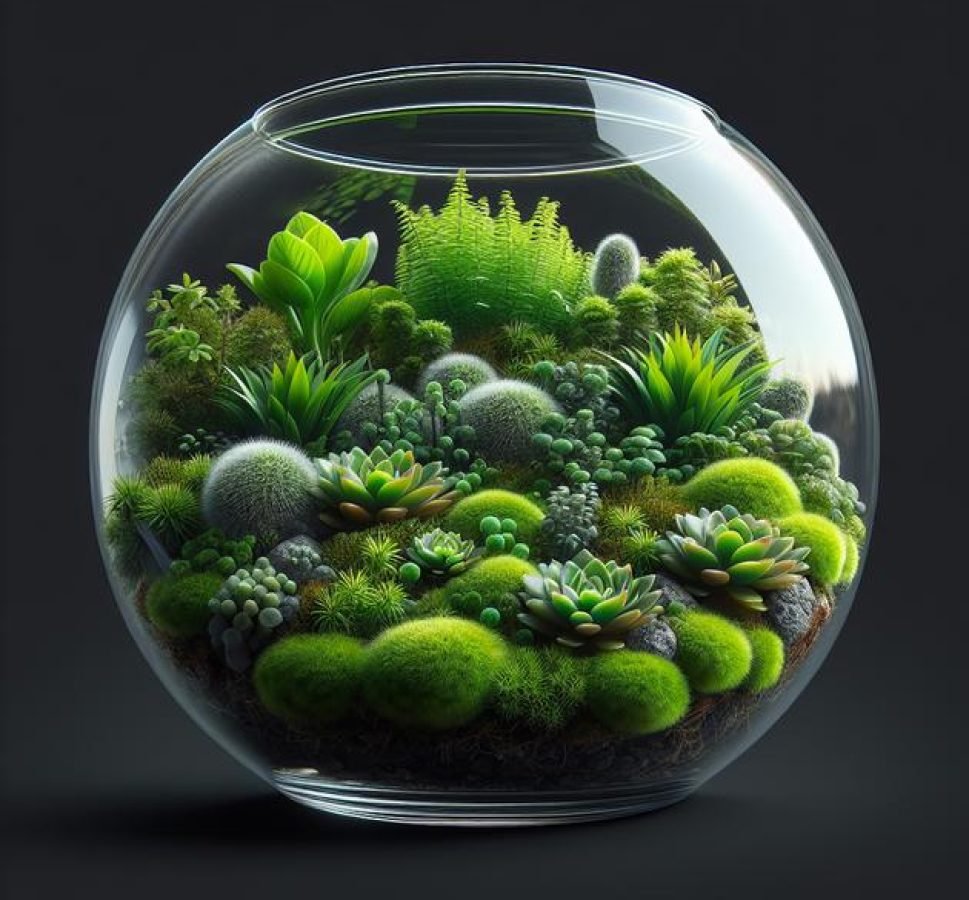DIY terrariums involve creating a mini indoor ecosystem by choosing suitable glass containers, selecting plants with similar care needs, preparing proper soil and drainage layers, arranging plants thoughtfully, and maintaining correct watering and humidity levels to ensure a healthy, low-maintenance environment.
Have you ever wondered how to craft your own green corner indoors? DIY terrariums offer a fun and creative way to bring nature home. Let’s explore how easy it can be to assemble a mini ecosystem that suits your style and space!
Choosing the right container for your terrarium
Choosing the right container is essential for building a successful terrarium. Glass containers are the most popular choice as they allow light to reach the plants and create a clear view of your mini ecosystem. Look for containers that are deep enough to hold soil and plants but also wide enough to allow proper air circulation.
Open vs. closed containers: Open containers help prevent excess moisture buildup, making them perfect for plants that prefer drier conditions. Closed containers, like jars or bottles with lids, maintain higher humidity and suit tropical plants that thrive in moist environments.
Consider the container’s shape too. Wide, shallow containers give you space to design creative layouts, while tall containers work well for plants that grow upward. Also, ensure your container has a stable base to avoid tipping over.
Remember, the container sets the tone for your terrarium’s style — from rustic to modern minimalism — so pick one that reflects your personality and fits your space.
Selecting plants that thrive indoors
When selecting plants for your terrarium, it’s important to choose species that thrive indoors and adapt well to the terrarium’s microenvironment. Popular choices include succulents, ferns, mosses, and air plants. These plants require minimal maintenance and generally prefer indirect light and moderate humidity.
Succulents prefer dry, open terrariums with good air circulation. Ferns and mosses, on the other hand, flourish in closed containers where humidity levels are higher. Air plants (Tillandsia) absorb moisture from the air and can survive in various container types without soil.
Consider the growth rate and size of the plants. Choose slow-growing species to avoid overcrowding and keep the terrarium looking balanced longer. Mixing plants with different textures and heights creates visual interest and mimics natural ecosystems.
Always research individual plant care requirements before adding them to your terrarium to ensure they will thrive together. Proper selection helps maintain a healthy, vibrant terrarium with minimal effort.
How to prepare the soil and drainage layers

Preparing the soil and drainage layers is crucial to ensure your terrarium plants thrive. Start by adding a layer of small pebbles or gravel at the bottom of your container. This layer prevents water from pooling around the roots, which can lead to rot.
Next, add a thin layer of activated charcoal on top of the pebbles. The charcoal helps keep the terrarium fresh by filtering toxins and reducing odors.
After these layers, add your potting soil or substrate suitable for your plants. Use soil that drains well but retains enough moisture. For succulents, a cactus mix works best, while ferns prefer a peat-based soil.
Layer thickness matters – make sure the drainage and charcoal layers are not too thick; otherwise, you may limit space for roots. Carefully level your soil layer to provide a stable base for planting.
By setting up proper drainage and soil layers, you create a healthy environment that balances moisture and air circulation, setting your terrarium up for success.
Arranging plants for a balanced ecosystem
Arranging plants properly is key to creating a balanced terrarium ecosystem. Start by placing taller plants like ferns or small palms toward the back or center for height and structure. Medium-height plants should go around the taller ones to provide layering and depth.
Fill spaces with low-growing plants such as mosses or succulents. These help cover the soil and add texture without overcrowding the container. Arrange plants with similar water and light needs together to make care easier.
Use asymmetry and varied textures to make the display look natural and appealing. Avoid packing plants too tightly, as good airflow reduces mold and root rot risks.
Leave small spaces between plants for air circulation and future growth. Adding decorative elements like small stones, wood pieces, or figurines can enhance the ecosystem’s look while keeping the plants the main focus.
With thoughtful arrangement, your terrarium will become a healthy, thriving mini garden that looks beautiful and lasts longer.
Tips for watering and maintaining humidity
Watering your terrarium correctly is vital to keep plants healthy without causing harm. Use a spray bottle to mist the plants lightly, avoiding overwatering which can lead to root rot. Closed terrariums need less frequent watering as they recycle moisture, while open terrariums may need watering once a week or when the soil feels dry.
Check humidity levels regularly by observing condensation on the glass. Some fog is good for tropical plants, but too much indicates excess moisture that needs airing out.
To maintain proper humidity, place your terrarium away from direct sunlight and heating vents, which can dry out the air. You can also add a small water dish or humidity tray nearby if needed.
Always water at the base of plants, avoiding leaves to reduce mold growth. Adjust watering frequency based on the plant types and the terrarium’s environment.
By carefully monitoring moisture and humidity, you create a thriving ecosystem with minimal maintenance.
Common mistakes to avoid in terrarium care

One common mistake in terrarium care is overwatering. Too much water can cause root rot and mold growth. Always check soil moisture before adding water and use a spray bottle for light misting.
Another issue is placing the terrarium in direct sunlight. Intense sunlight can overheat the plants and create a greenhouse effect, damaging them. Instead, keep your terrarium in bright but indirect light.
Avoid using plants with very different care needs in the same terrarium. Mixing high moisture plants with drought-tolerant ones leads to stress and poor growth for some species.
Also, be careful with neglecting ventilation. Closed terrariums need occasional airing to prevent excess humidity and mold, while open terrariums benefit from good airflow.
Lastly, avoid overcrowding your terrarium. Giving plants enough space for roots and leaves to grow promotes a healthier and more balanced ecosystem.
Creative ideas to personalize your terrarium
Personalizing your terrarium allows you to express creativity and make a unique piece of living art. Consider adding small decorative elements like colorful stones, miniature figurines, or shells that reflect your personality or theme.
Use different types of containers such as vintage glass jars, geometric terrariums, or repurposed objects to add character. You can also layer contrasting soil colors or add tiny fairy lights inside for a magical effect.
Another idea is to include unusual plants like air plants or carnivorous species to give your terrarium a distinct look. Play with textures and heights by mixing moss, succulents, and taller plants.
Personal touches like natural wood pieces, driftwood, or crystals can create an inviting atmosphere and connect your terrarium with the environment.
Remember, your terrarium is a miniature world — make it reflect your style and enjoy caring for it as a living decoration.
Troubleshooting plant health issues in terrariums
Diagnosing plant health issues in terrariums is key to maintaining a thriving ecosystem. Yellowing leaves often indicate overwatering or poor drainage. Check the soil moisture and reduce watering if necessary.
Wilting or drooping plants might mean underwatering or insufficient humidity. Increase misting and ensure the soil stays slightly moist, especially for tropical species.
Look out for mold or fungal growth, which can appear as white or gray fuzz on the soil or plants. This usually results from excess moisture and poor ventilation. Open the terrarium occasionally to improve airflow and avoid overwatering.
Pests like aphids or spider mites can damage plants as well. Inspect plants regularly and remove pests gently with a cotton swab dipped in soapy water or use natural insecticides suitable for indoor plants.
Proper care, timely intervention, and maintaining balanced conditions help prevent and fix common terrarium plant problems.
Bringing your terrarium ecosystem to life
Building and maintaining a terrarium is a rewarding journey that combines creativity and nature. By choosing the right container, plants, and proper care techniques, you can create a stunning mini garden that thrives indoors.
Pay attention to watering, humidity, and common mistakes to keep your plants healthy and vibrant. With patience and observation, troubleshooting becomes easier, ensuring your terrarium remains a lively ecosystem.
Whether for decoration or relaxation, your DIY terrarium adds a touch of green to your space while teaching you about balance and care in nature.
Start building your own terrarium ecosystem today and enjoy the beauty of a self-sustaining mini garden in your home.





